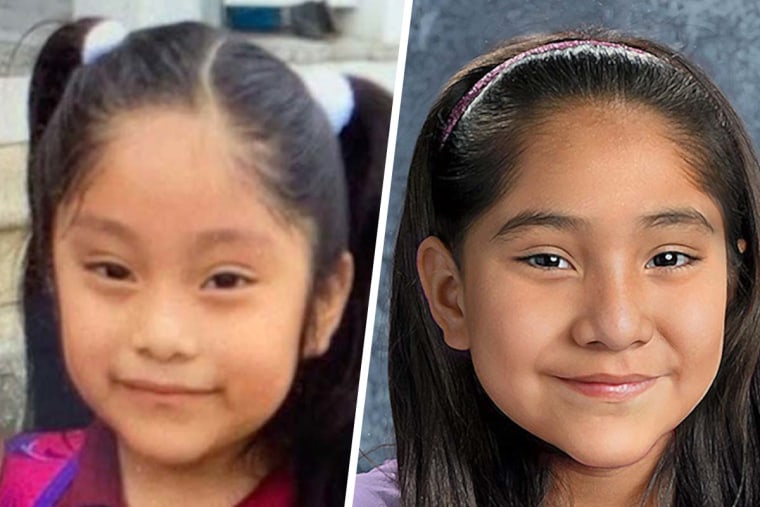Noema Alavez Perez says that she relives what happened on Sept. 16, 2019, every day, and she always remembers the last thing she saw: the smiles of her children, Dulce María and Manuel, eating ice cream while playing in a park in Bridgeton, New Jersey.
“The children got out and I stayed with my sister in the car because she was doing her homework. I was on the phone and scratching a lottery ticket and I remember that I could see where the slide was, but not where the swings were," Alavez Perez, 23, told Noticias Telemundo. "I didn’t think something so ugly like that was going to happen. I lowered my head for a few minutes and, suddenly, I didn’t see them anymore. When I went to look, I found Manuel crying."
She has not seen her daughter since.
New Jersey police, the FBI and various search organizations are still searching for Dulce María and offering a reward of $75,000 for clues about her whereabouts. Dulce María was 5 when she disappeared and turns 10 on April 25.
“The police and the FBI believe that someone we know took her, because Dulce would not have gone with a stranger, and we believe the same," said Alavez Perez between sobs. "We just want to think that she is fine and will return to us one day.”
According to an analysis by Noticias Telemundo, based on data from the National Center for Missing and Exploited Children (NCMEC), as of Thursday, April 4, there were 414 children up to 12 years old reported as missing in the U.S. in official records from 2003 to 2023. Hispanic children lead that statistic with 130 reported cases, followed by white children, with 94 cases, and Black children, with 90.
"In general we have about 4,500 missing minors in the United States who have active wanted posters on our website. Those are only the cases that we know of; of that number, around 23% are Hispanic/ Latinos. It is certainly a large population that worries us," said John Bischoff, the center's vice president of the missing minors division.
According to Bischoff, NMEC statistics on missing children are based on official records from the FBI’s National Crime Information Center (NCIC) and the National Missing and Unidentified Persons System (NamUs).
However, Bischoff said, in many cases, the center’s data is more precise than that of other agencies since the ethnicity field is optional when cases are registered in the NCIC. For NamUS, the records are voluntary rather than federally mandated. This explains why there are often discrepancies in the general figures of missing people in the U.S.
“Collecting data on missing people of color poses numerous problems,” said Danielle Slakoff, a criminal justice professor at California State University-Sacramento. "In official data sources, Hispanics are often grouped with whites. Missing Indigenous people are also often misclassified."
Noticias Telemundo contacted both systems to find out the current number of missing people in the country. As of Feb. 1, NCIC had 7,141 missing people registered who had been identified as Hispanic/Latino. However, as of Feb. 27, NamUS had 4,670 people registered as Hispanic or Latino. Neither system specified how many of the missing are children.
According to NamUS, more than 600,000 people are reported missing each year, but it also specifies that “many missing children and adults are found quickly, safe and sound.” In 2023, Office of Justice Programs Assistant Attorney General Amy L. Solomon stated that about 460,000 children are reported missing in the U.S. annually.
Why do children go missing?
Bischoff said the causes of disappearances for Hispanic minors fall into the same general categories as other population groups. The center groups reports into several sections, including fugitives in danger, family abductions, nonfamily abductions, and missing, injured or missing for other reasons.
“Endangered runaways make up about 91 to 92% of our caseload. These are children who left what is perceived as a safe environment. If we went back five or 10 years, you could say they ran away, but today, we see that there is a tendency that children meet someone online and maybe go out to talk or be with that person. And that is a big concern,” Bischoff said.
The next important category is family abductions, which occur when a relative takes a minor without the consent of the rest of the family, and which represents around 5% of the center’s records, Bischoff said.

Other experts, such as Trent Steele, director of the Anti-Predator Project, a nonprofit organization dedicated to combating human trafficking and sexual predators in the U.S., believe that the higher incidence of Hispanic children reported missing has to do with specific issues plaguing marginalized communities.
“I think that in the Latino and Black communities, the numbers are a little higher because they are affected by situations of poverty and inequality," Steele said, adding that "many are put in situations where they disappear and flee.”
Alavez Perez, who was born in the U.S. to Mexican parents, also believes that many relatives of Hispanic children trust that the U.S. is safer than Latin American countries and sometimes make mistakes.
“There are parents who think that our children are going to be fine here," she said. " I believed that my daughter was going to be safe in that park, because my parents also let me go play alone and nothing would happen to me. I had that confidence of letting my children play, I wasn’t with them for a few minutes, and this happened to me,” she said with despair.
Steps to take when a child disappears
Both Bischoff and Steele agreed that after checking with relatives, friends and caregivers, the first thing a family member with a missing child should do is contact the police in the area.
“Your second phone call should be to us, to the National Center for Missing and Exploited Children. We have a call center, operating 24 hours a day, seven days a week, 365 days a year. They are always there to answer questions. When a child is missing, you have to give all the information and help the authorities spread the word,” Bischoff said.
Steele said that when his organization becomes involved in a search, the first thing it does is request the electronic devices the child has used to thoroughly review them.
“We have seen a large increase in cases where children participate in online activities and then leave to meet someone they have met online. Then we review every aspect of what happened the day that child disappeared, what happened in the days before and in the days after, you have to know who you have spoken to, who has been in the child’s life and what type of activities they were involved in,” Steele said.
Alavez Perez contacted Steele’s team at the Anti-Predator Project to look into Dulce María’s case, and they're now working with authorities to investigate new leads about the disappearance.
“This case is not closed. There are several leads that we are following right now. We have an address, and it is going to take us some time to sort out everything we have,” Steele said about Dulce María's search.
‘I miss her so much’
In September 2023, the Cumberland County Prosecutor’s Office and Bridgeton Police said in a joint statement that due to the “absence of evidence confirming Dulce’s death, investigators are hopeful that Dulce is still alive.” In addition, they claimed that hundreds of interviews had been conducted and that the detectives had traveled to other areas of the U.S. and Mexico to follow up on leads in the case.
The Bridgeton Police Department, the Cumberland County Prosecutor’s Office and the New Jersey State Police Missing Persons Unit didn't respond to requests for comment on Dulce María’s case.
Alavez Perez said she has not lost hope of finding Dulce María.
“Every day I think about my missing daughter, it is difficult to continue living a normal life without knowing where she would be,” she said. “I want to tell my daughter that I love her and that I miss her so much and I’m dying to be with her. I ask that person who knows something about my daughter to please speak up."
If you, or someone you know, needs to report the disappearance of a minor or share information about their whereabouts, you can report it by calling 911, or you can also call the National Center for Missing & Exploited Children toll-free at 1-800-843-5678. You can also contact the nearest local or international FBI office.
An earlier version of this story was first published in Noticias Telemundo.
